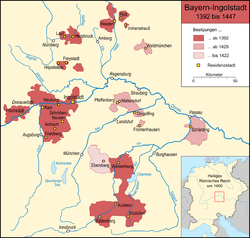Bavaria-Ingolstadt
| Bavaria-Ingolstadt Teilherzogtum Bayern-Ingolstadt | |||||||||
|---|---|---|---|---|---|---|---|---|---|
| 1392–1447 | |||||||||
 The Duchy of Bavaria-Ingolstadt (1392–1447) | |||||||||
| Status | Duchy | ||||||||
| Capital | Ingolstadt | ||||||||
| Government | Monarchy | ||||||||
| Duke of Bavaria-Ingolstadt | |||||||||
• 1392–1413 | Stephan III | ||||||||
• 1413–1447 | Louis VII | ||||||||
• 1443–1445 | Louis VIII | ||||||||
| Historical era | Middle Ages | ||||||||
• Division of Bavaria-Landshut | 1392 | ||||||||
| 1443 | |||||||||
• Annexed by Bavaria-Landshut | 1447 | ||||||||
| |||||||||
Bavaria-Ingolstadt (German: Bayern-Ingolstadt or Oberbayern-Ingolstadt) was a duchy which was part of the Holy Roman Empire from 1392 to 1447.
History
After the death of Stephen II in 1375, his sons Stephen III, Frederick, and John II jointly ruled Bavaria-Landshut. After seventeen years, the brothers decided to formally divide their inheritance. John received Bavaria-Munich, Stephen received Bavaria-Ingolstadt, while Frederick kept what remained of Bavaria-Landshut.
After Stephen's death in 1413, Louis VII assumed his father's throne. In 1429 parts of Bavaria-Straubing were united with Bavaria-Ingolstadt. Louis reigned until his own son, Louis VIII, usurped his throne in 1443 and delivered him to their enemy, Henry XVI, duke of Bavaria-Landshut. Louis VIII died two years later. Louis VII died in captivity. With no heir, Bavaria-Ingolstadt was returned to Bavaria-Landshut.
Geography
Bavaria-Ingolstadt was cobbled together from diverse, non-contiguous territories in Bavaria. The capital was Ingolstadt and included the territories around it: Schrobenhausen, Aichach, Friedberg, Rain am Lech and Höchstädt an der Donau. In addition, Bavaria Ingolstadt incorporated the following towns:
Southern Bavaria:
Eastern Bavaria:
Northern Bavaria: